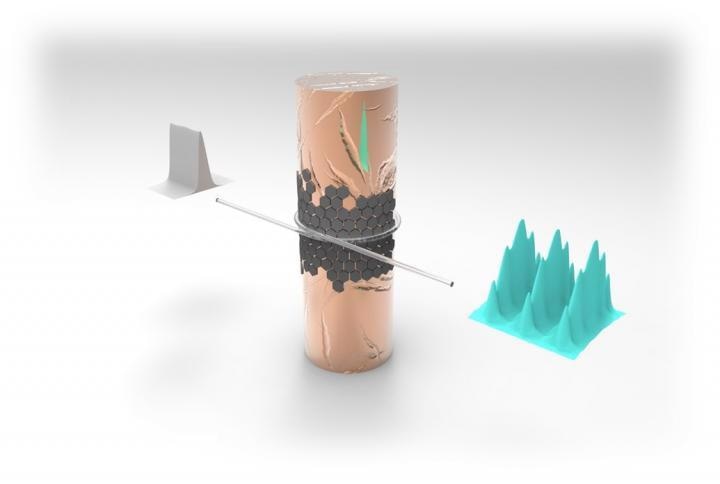Jan 20 2021
Pulsed lasers tend to emit light repeatedly for a short period as if they blink. They can focus more energy compared to a continuous wave laser, whose intensity remains unaltered over time.
 Abstract illustration. Image Credit: Korea Institute of Science and Technology.
Abstract illustration. Image Credit: Korea Institute of Science and Technology.
Loading of digital signals in a pulsed laser enables each pulse to encode one bit of data. In this case, the repetition rate is directly proportional to the amount of data that can be transmitted. But traditional optical-fiber-based pulsed lasers have essentially been unable to increase the number of pulses per second above the megahertz (MHz) level.
At the Korea Institute of Science and Technology (KIST), a team of researchers headed by Senior Researcher Dr Yong-Won Song from the Center for Opto-Electronic Materials and Devices has been successful in producing laser pulses at a rate of at least 10,000 times higher compared to the state of the art.
This was achieved by inserting an additional resonator with graphene into a fiber-optic pulsed-laser oscillator that works in the domain of femtoseconds (10−15 seconds). It is expected that the data transmission and processing speeds will considerably increase by applying this technique to data communications.
The KIST researchers observed that the properties of the wavelength and intensity of laser light that vary over time are correlated (Fourier transform). The insertion of a resonator into the laser oscillator leads to the periodical filtering of the wavelength of the pulsed laser, thus modifying the pattern of laser intensity change.
Using this background study as the basis, Principal Researcher Song produced graphene, which has the properties of absorbing and removing weak light and amplifying the intensity by allowing only strong light into the resonator. This enables the variation in the laser intensity to be precisely manipulated at a high rate, thereby enabling the repetition rate of pulses to be increased to a higher level.
Moreover, graphene is essentially produced onto a catalytic metal’s surface, following which the product is isolated from the catalyst and transferred to the surface of a preferred substrate. This method has typically involved the problem that graphene gets damaged or impurities are introduced.
The KIST research team mentioned above overcame the issue of reduced efficiency that occurs in the manufacturing process by the direct formation of graphene onto a copper wire’s surface, which can be obtained easily, and by further coating the wire with an optical fiber so that it can be used as a resonator.
Consequently, the researchers were able to achieve a repetition rate of 57.8 GHz, thus solving the drawbacks of pulsed lasers with respect to repetition rate, essentially constrained to MHz. Moreover, the property of graphene where heat is locally produced upon absorbing the laser was leveraged to adjust the properties of the graphene resonator by introducing an additional laser to the device.
In the current scenario, in which the demand for data traffic is increasing exponentially, ultra-fast pulsed lasers operating at ultra-high speed and admitting tuning characteristics are expected to provide a new approach to adapt to this rapidly changing data-processing scenario.
Seong-Jae Lee, Researcher, KIST
According to Principal Researcher Song, who led the study research, “We expect that the development of ultra-fast pulsed lasers based on resonators and graphene will bring our lead in technology development and related market within the field of nanomaterial-based optical information devices.”
This research was performed with a grant from the Ministry of Science and ICT (MSIT), as part of the Institutional R&D Program of KIST.
Journal Reference:
Lee, S & Song, Y-W (2021) Graphene Self-Phase-Lockers Formed around a Cu Wire Hub for Ring Resonators Incorporated into 57.8 Gigahertz Fiber Pulsed Lasers. ACS Nano. doi.org/10.1021/acsnano.0c07355.